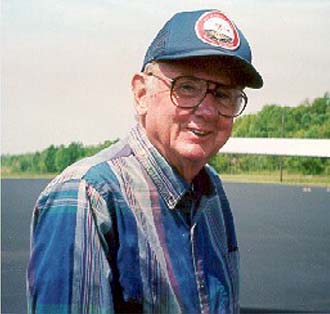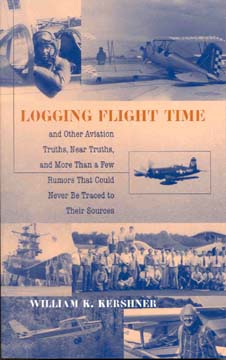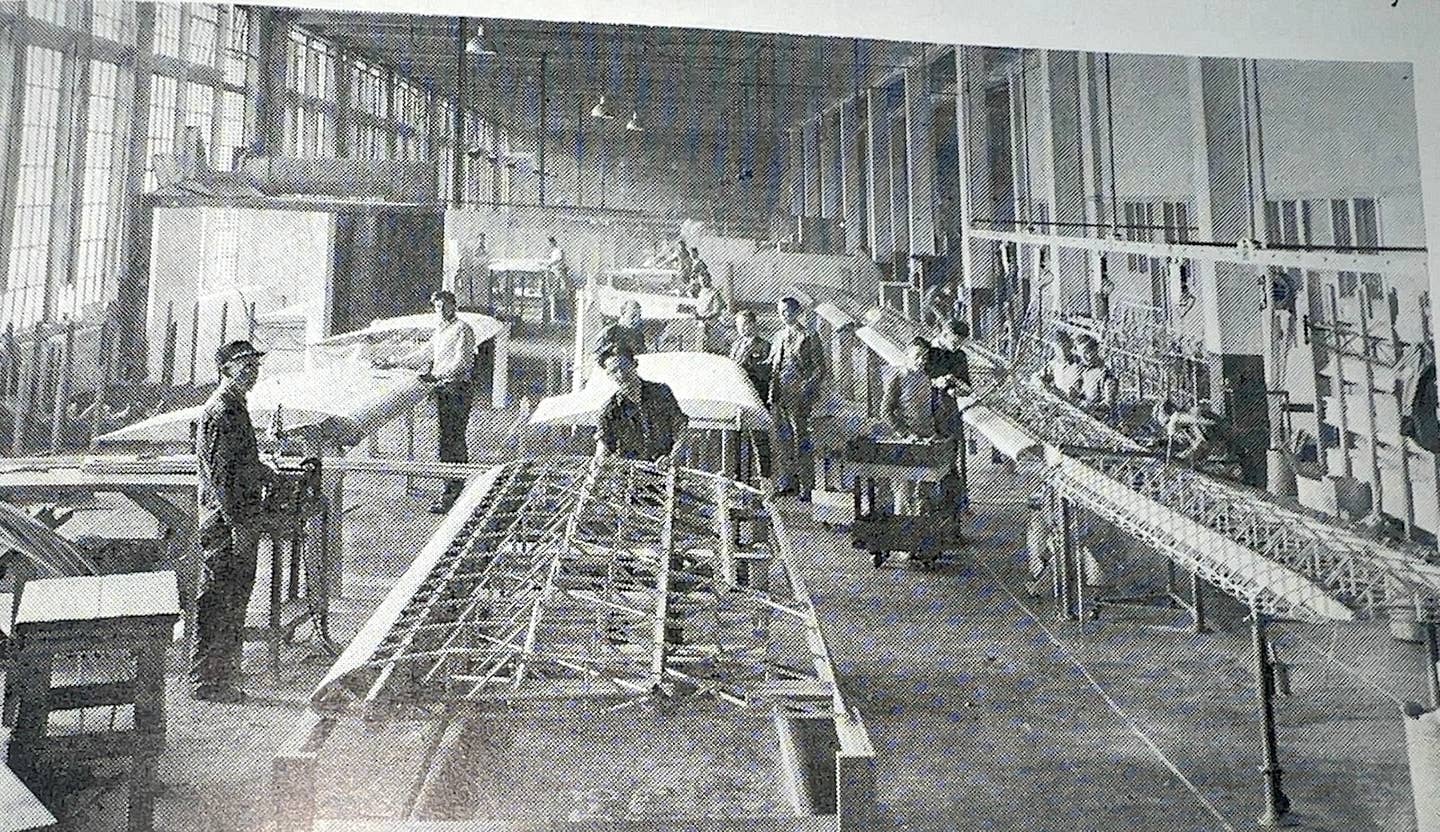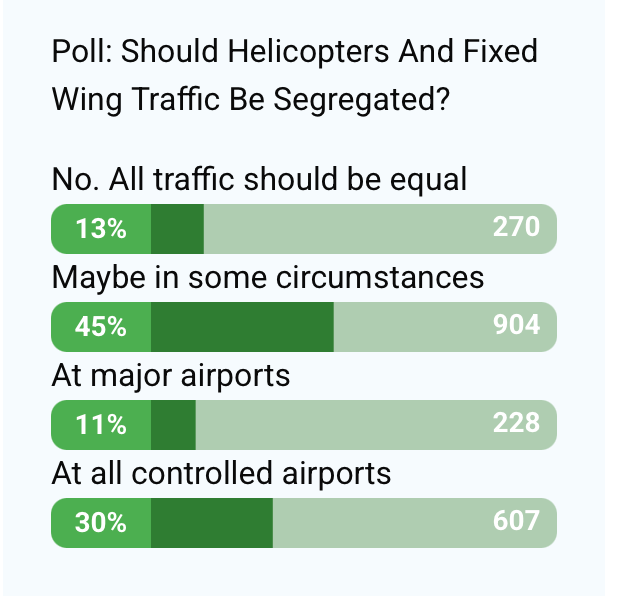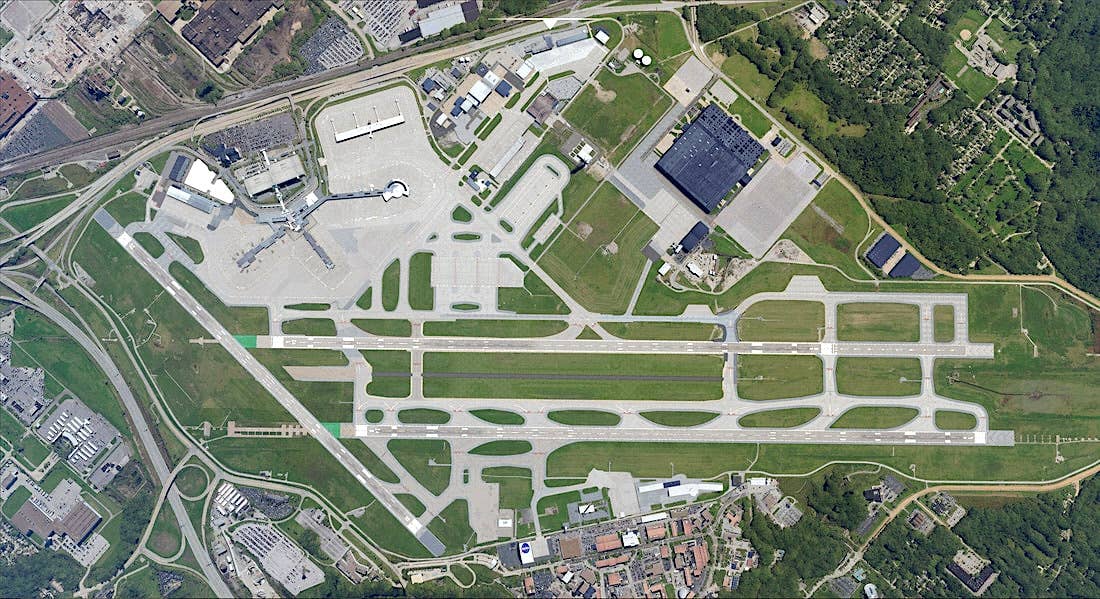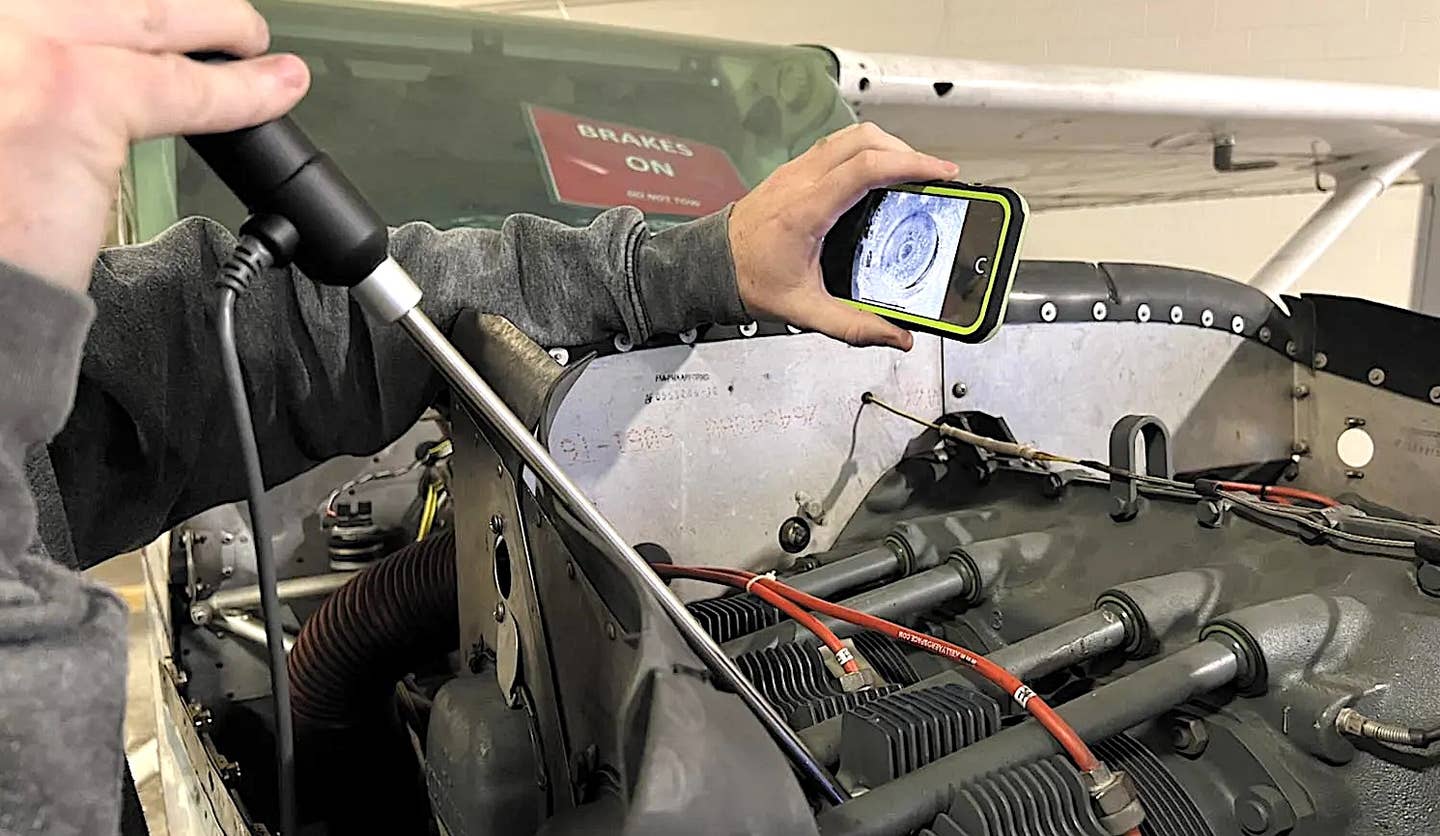Bill Kershner
In 1958 Bill Kershner was a student looking for a project to blend his interests in aeronautical engineering and journalism. He took a look at the Civil Air Manual 105, decided it was poorly written, and decided to write his Student Pilot’s Flight Manual. It’s now in its ninth edition with over 800,000 copies sold. In this month’s Profile, AVweb’s Joe Godfrey talks with Bill about his books, his aerobatic school, and lessons learned over 57 years of flying.
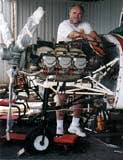
In 1958 Bill Kershner was a student looking for a project to blend his interests in aeronautical engineering and journalism. He took a look at the Civil Air Manual 105, decided it was poorly written, and decided to write his Student Pilot's Flight Manual. It's now in its ninth edition with over 800,000 copies sold. In this month's Profile, AVweb's Joe Godfrey talks with Bill about his books, his aerobatic school, and lessons learned over 57 years of flying.
William K. Kershner was born September 27, 1929, in Clarksville, Tenn. He started flying lessons at age 15 and paid for them by fueling, washing and propping airplanes. He earned his private certificate in 1946, his commercial in 1948, and his CFI in 1949. After two years of college at Iowa State University in Ames, Iowa, he entered the Navy as an aviation cadet, and received his wings in February 1953. He served in VC-3 flying F4U-5N Corsairs from the carrier U.S.S. Philippine Sea. After returning to the U.S. in November 1954, Bill was a navigation and instrument training officer, chase pilot in F9F-6 Cougars and jet-transition training officer in T-33s for VC-3. He was released to inactive duty in August 1955. In October, 1955, he joined Texas Gas Transmission Corp. in Owensboro, Ky., as an executive pilot flying Bonanzas, Aero-Commanders, Twin Beeches and DC-3s. In June, 1958, he returned to Iowa State, wrote the Student Pilot's Flight Manual and graduated with a degree in technical journalism in 1960. Bill worked at Piper Aircraft Corp. in Lock Haven, Pa., as a contract sales engineer from 1960 to December, 1963, demonstrating airplanes at various U.S. military bases, assisting W. T. Piper, Sr. with his Piper Airpark Program, and publishing the Private Pilot's Flight Manual -- now titled Advanced Pilot's Flight Manual. In late December, 1963, he accepted job of Supervisor of Experimental Flight Testing at Piper. By June, 1964, increasing book sales allowed him to move to Sewanee, Tenn., where he now lives.
In 1969, Kershner began teaching aerobatics in a Beech Musketeer Aerobatic Sport III. From 1977 to 1979 he taught the course in a Cessna 150 Aerobat, and since 1984 he has used a Cessna 152 Aerobat. At his Ace Aerobatic School, he has taught over 500 students from all over the U.S. including 45 Army aviators, FAA test pilots and other personnel, aspiring Navy and Air Force pilots, and others interested in learning "defensive flying." His lectures on spins and low-speed flight have taken him to the University of Tennessee Space Institute, the Patuxent Naval Air Test Center and the FBI Academy in Quantico, Va. His Student Pilot's Flight Manual is in its ninth edition, with 34 printings and over 800,000 sold. His Advanced Pilot's Flight Manual is in its sixth edition, with 28 printings and 281,000 sold. His Instrument Flight Manual is in its sixth edition, with 22 printings and 176,000 sold. He has also written a Flight Instructor's Manual, co-authored a Student Pilot's Ground School Manual, and written articles in AOPA Pilot, Smithsonian Air and Space, Flying, Air Progress, Skyways, Private Pilot and other aviation magazines. His latest book -- Logging Flight Time - and Other Aviation Truths, Near Truths, and More Than a Few Rumors That Could Never Be Traced to Their Sources -- is a collection of articles, some previously unpublished. Bill's books can be ordered from the Iowa State Press website. These days he's teaching, doing spin research, keeping his publications up-to-date, and last month he was inducted into the Tennessee Aviation Hall of Fame.
Let's start with a story from your latest book. Tell us about your private checkride.
I was nervous as could be because I had to wait several months to be old enough to take the test. We were wearing parachutes because in those days you did spins -- you had to do a two-turn spin in both directions and recover within ten degrees -- which wasn't difficult in those older airplanes with big rudders. We went through the whole list of maneuvers and when we got low to do figure eights, I happened to look down and saw both halves of the seatbelt hanging down. I tried to distract the examiner but he had already been looking at them for 45 minutes. I fastened the belt.
When we landed I was sure I had failed the checkride. I stood by the plane while he went in the office. It was silent for a while then the whole office broke into laughter. The examiner told me to come in and asked me "What's the first thing you do when you get into an airplane?" and I said "Fasten your safety belt." He said "You passed." After that I used a safety belt even I was just taxiing an airplane, and now there's a regulation for it -- I think they got it from me.
In those days we called them safety belts, and after calling them seat belts for a while, they've now started calling them safety belts again. I have seen a lot of that in my 57 years of flying -- changing something then changing it back.
Give us another example.
When I learned to fly we called it slow flight -- you flew right on the edge of a stall and any backpressure would cause a stall. Then it was called flight at critical airspeed, then they called it minimum-controllable airspeed, and now it's back to slow flight again.
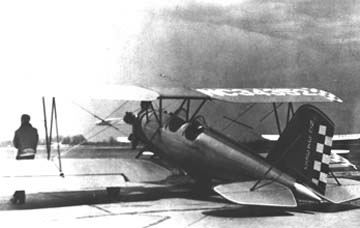 | |
| CFI Bill Kershner waits for a commercial student by leaning on a Meyers OTW with a 160 hp five-cylinder Kinner engine; October, 1949 |
Partial panel flying is another. I'm a strong believer that if you're going to be an instrument pilot you'd better learn how to fly the turn and slip indicator -- that's what I have in my airplane, I took the turn coordinator out. In my Instrument Flight Manual I emphasize partial panel flying ability. Meanwhile, the FAA decided that with gyros powered from different sources we didn't need to train for partial panel. Then they had some fatal accidents due to vacuum failures and they put it back in the training and on the practical test.
I had left it in the book because I think pilots ought to be able to do it. Someone called me about a week after the FAA reinstituted it on the flight test and said "I can't believe it! The FAA just changed the requirements and you've already got it in your book." That's because I never took it out.
Are you a designated flight examiner?
No, I'm not. I've turned it down several times. I have my own ideas of teaching and there are some things the FAA does that I don't agree with. It doesn't mean that I'm right and they're wrong, but I think if you're going to do their work you should agree with them.
Give us an example of something you disagree about.
Power and pitch. I teach that the elevator always controls airspeed -- or, more properly, angle of attack -- and power controls altitude. Having been a carrier pilot in Hellcats and Corsairs I'm adamant on that. If my students are undershooting the field I want them to think in terms of power, not elevator. And I don't use the idea of primary and supporting in instrument flight -- that's the most confusing thing I've ever seen. I teach the concept of performance and control instruments, and I think the FAA is moving in that direction.
I also teach spins a bit differently. My CFI candidates do 20 spins and the recovery procedure in a 152 is the same for 20 as it is for three. I also teach them how to recover using instruments and not to pay any attention to the ball. The ball goes to the left if it's on the left side of the panel, and goes to the right if it's on the right side -- no matter which way you're spinning. The way I discovered that is I was spinning a 150 and the ignition key had a long tag on it, and no matter which way I spun it the tag went the same way.
I think sooner or later we'll be able to find the spin axis in flight, at least longitudinally, and we'll see the spin axis moving toward the centery of gravity, or vice versa, and we'll know we're going flat. If you had a computer that could see that the axis moved one millionth of an inch -- long before the pilot would become aware of it -- then recovery procedures would start automatically before it went flat.
Should spin training be part of the private pilot test?
No. I certainly encourage spin training -- every pilot should have it -- but if they said "Tomorrow at noon, everybody has to have spin training" our problem is we don't have instructors to teach it -- particularly the latest crop of instructors. CFIs -- who are supposed to have had spin training -- come to take my spin training course and tell me "My instructor was afraid of spins and just signed me off." I'm amazed at the number of instructors I've seen who have had one turn in each direction and then signed off.
You usually don't get into a spin the way we teach them -- by raising the nose with the wings level. You'll get into them from a cross-controlled turning-final skidding stall, or an over-the-top departure stall. But straight ahead is a good way to introduce them to the concept. When we get through spin recoveries after 20 turns, recovering with ailerons alone, recovering with elevator alone -- and I don't advocate those recovery techniques for private pilots, I'm talking about CFIs -- you can almost see the confidence level raise.
Another problem with requiring it is somebody may go do it in an airplane that hasn't been approved for spinning. You also see flight schools training multiengine pilots who have never feathered a prop, because the school doesn't want to feather their props. It's probably not a huge number, but I'm sure they're out there.
When I worked for Piper Aircraft Company I used to demonstrate single-engine takeoffs in the Aztec.
You don't mean failing an engine, you mean starting from the takeoff roll?
Right. I'd keep the other engine at zero thrust and start the takeoff -- I'm not that crazy. The Aztec was very forgiving. I did a lot of single-engine test flying in the Apache, also.
You've seen a lot of pilots. Is there one that stands out above the rest as the best you ever saw?
One fellow you don't hear much about is Corky Meyer. He was a test pilot for Grumman on the F6F, the F7F and the F8F, and the Cougar and the Panther. He's one that I admire.
Did you teach your children to fly?
My daughter doesn't care for flying at all. I taught my son and he's a captain for a major airline. Someone asked me "When you soloed him, didn't you think 'That's my son I'm sending up there!'" Not really. Everybody is somebody's son. I've never gotten maudlin about soloing him or anyone else. You just make sure they're ready to go and get out of the plane.
Where are some of the memorable places you've flown?
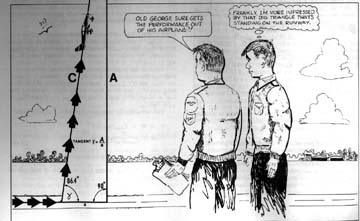 | |
| Vintage Kershner humor -- Two IAC (International Aerobatics Club) Pilots: "Old George sure gets the performance out of his airplane!!" "Frankly, I'm more impressed by that triangle standing on the runway." (Kershner not only writes the text for his books -- he draws, too.) |
I've landed at places I didn't intend to land. There's a story in my new book about landing in a garden in Memphis because we had drained a lot of water from a the tanks of an Aeronca, but we hadn't drained it all. I flew Mr. Piper into Flushing airport on Long Island. The approach was between apartment buildings and you could look in the window as you went by. When I was a student at Iowa State I flew chickens from Iowa and Minnesota to Midway Airport in Chicago in a Bonanza. I would climb into the airplane and they would pile the boxes of chickens around me. They were selected breeding chicks and when I dropped them at Midway, they caught a Lufthansa flight to Germany. I could swear that after a few hours in the Bonanza they were peeping with German accents. My son and I have a map and we put red and blue pins at airports we've landed and taken off from as pilots. I have 303 and he's catching up with me. He wouldn't let me count the four carriers I've flown from -- he says they were moving all the time. I'm quite content to fly around the southeast U.S. now.
I've been instructing for 53 years and my theory is that if you've done a good preflight check and a good run-up, you've probably taken care of 99.99% of any problems. Even instructors don't want to use the checklist. I was using the checklist on my Aerobat and a CFI asked me "Didn't you write the Cessna 150 Aerobatic Training Manual?" I said "I did, with a lot of help from Cessna." He said "Then why are you using a checklist?" and I said "Because I might forget something."
Do students that take your aerobatic course fly your 152 Aerobat?
Yes. Someone called the other day and asked if he could bring his Decathlon up and take the course in it. In an Aerobat I feel that I can teach aerobatics just about as well as anyone, but I haven't instructed in a Decathlon in almost 20 years, and I would need 10 or 12 hours in a Decathlon to feel like I was giving him his money's worth.
Some people laugh at the 152. Well, it's not an F-16, but I can do square loops, eight-sided loops, four-point rolls, eight-point rolls, and vertical snaps. I don't do them with students, but I do them at the 4th of July airshow. The Aerobat is just fine for me to teach aerobatics. I've had two students call to tell me the course saved their lives. One was in an A-36 Bonanza and came out of the clouds inverted and he could remember my voice saying "Push and Roll! Push and Roll!"
Where did you gather all the information to put in your books?
After I got out of the Navy I flew for a corporation for three years. It was fun and interesting flying from point A to point B and back, but the chief pilot was only three years older than I was, so there wasn't a lot of opportunity for advancement there. I went back to school and studied aeronautical engineering and journalism, and I was looking for a way to tie them together. I instructed at the Ames airport and one afternoon, one of the students brought in a copy of the Civil Air Manual 105 -- the predecessor of the AC-21 Flight Training Handbook -- and said "I don't understand this." I hadn't seen one in a long time and when I took a look it was poorly written, didn't have any pictures, and no humor at all.
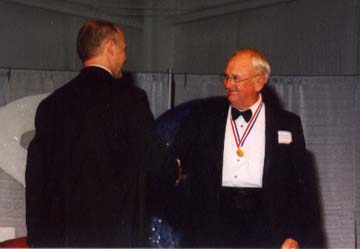 | |
| Captain Bill Kershner, Jr. (l) introduces his father at his induction into the Tennessee Aviation Hall of Fame; September, 14, 2002 |
Every English teacher I ever had in school said "Whatever you do, do not write for a living," but I decided I wanted to write a flight manual as a journalism project. I was carrying 21 credit hours and working to support my family, and I wrote most of that book between midnight and two a.m. over six weeks -- it was just pouring out. My wife typed the manuscript and I drew the illustrations right on the page, just like it would be published. The book almost didn't get published because one of the professors on the manuscript committee said "This guy's not academic enough. He's writing this book as if he's talking to somebody. It won't sell 200 copies." That book just hit 800,000 copies. I wrote Advanced Pilot's Flight Manual while I was a test pilot at Piper. I wrote the Instrument Flight Manual and the Flight Instuctor's Manual in Sewanee. The new edition of the Flight Instructor's Manual came out earlier this month. I would have sold all the rights to the first book for $2,000. I'm very glad I didn't, but, back then, nobody offered. All the books together have sold 1.4 million copies.
800,000 has to be the best-selling flight instruction book ever.
I don't know, and I'm sure the big publishers are catching up with me. Students now have choices, and that's good. What's not good from the student perspective is when a flight school says "We use a certain book and we don't use anything else." I don't know how to sail a boat -- the smallest ship I was on was a carrier and they wouldn't let me play with it -- but if I were going to be serious about learning something I'd want everything I could get my hands on.
Iowa State Press does not advertise like others do, but I have the advantage that mine is still a two-person operation. I decide what goes into the book and do the drawings, and my editor at Iowa State checks the grammar and punctuation. I tell flight schools that if they have a gripe they can call me up with a suggestion and if I use it I'll give them credit in the front of the book. It's nice to have that much control over what I write.
I think one of the most instructive things in your books is the common errors you list after each maneuver. I've found myself in that paragraph more than once. How did you learn so much about how we learn?
I started instructing right after my 19th birthday, and I instructed in the Navy, and I kept my eyes and ears open when other instructors talked about common errors that I hadn't even run into yet. Plus the fact that I've made most of those mistakes myself.
What do you like to do when you're not flying?
Read about it. My wife and I like to take hikes. My son and I took my five-and-a-half year-old grandson fishing last week and he caught his first fish -- it must've been four inches long. I do like to read about flying. You would think after 57 years I've have gotten tired if it, but I can sit here with a book on stability and control and be quite content. I'm always trying to learn and I find that the more I learn the less I know.
Not to take anything away from your writing, but have you considered turning your books into videos and Web sites?
My goal is to write the best books there are. I like books because you can carry them around without extra equipment. If you're looking for something, you go the index and go to that page and there it is. You don't have to run it backwards and forwards to find what you want. I'm working on a aerobatic flip book -- you flip the pages and the airplane does the maneuver. Each page explains what's going on at that point, then you can flip it to see the whole maneuver together, and you can keep it in your pocket. I like books and that's what I'm going to stick with.
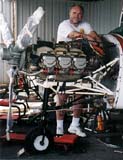 JoeGodfrey mixes his love of flying with a love of music. He is an instrument-rated private pilot who flies a 1974 Bellanca Viking based at Palomar airport just north of San Diego, Calif. He composes music for commercials, films, broadcast and corporate media and has composed and produced thousands of music tracks for America's largest advertisers. He'll be playing bass with Eugene Levy and Catherine O'Hara in "A Mighty Wind" -- Chris Guest's spoof of folk music due out in the spring of '03. Find out more at Joe's website. In addition to writing for AVweb, Joe has written for AOPAPilot, The Aviation Consumer, Twin and Turbine and IFR magazines. He is a pilot and ex-director of AngelFlight West, a nonprofit organization that uses private airplanes to flyindigent medical patients. He is married and lives in Leucadia, Calif. So far,Joe is the only AVweb staff member who has logged time with Ella Fitzgerald andconducted the London Symphony.
JoeGodfrey mixes his love of flying with a love of music. He is an instrument-rated private pilot who flies a 1974 Bellanca Viking based at Palomar airport just north of San Diego, Calif. He composes music for commercials, films, broadcast and corporate media and has composed and produced thousands of music tracks for America's largest advertisers. He'll be playing bass with Eugene Levy and Catherine O'Hara in "A Mighty Wind" -- Chris Guest's spoof of folk music due out in the spring of '03. Find out more at Joe's website. In addition to writing for AVweb, Joe has written for AOPAPilot, The Aviation Consumer, Twin and Turbine and IFR magazines. He is a pilot and ex-director of AngelFlight West, a nonprofit organization that uses private airplanes to flyindigent medical patients. He is married and lives in Leucadia, Calif. So far,Joe is the only AVweb staff member who has logged time with Ella Fitzgerald andconducted the London Symphony.

